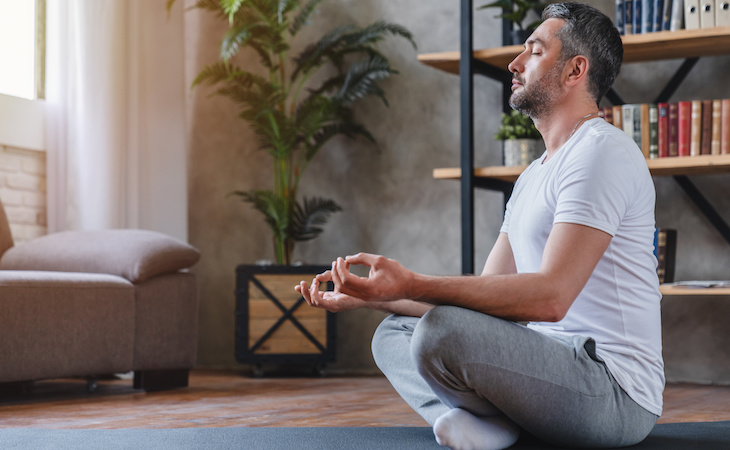Imagine being able to enjoy the benefits of an afternoon power nap without needing to sleep, including possibly even improving your nighttime sleep.
There are a ton of relaxation techniques out there that claim to improve sleep. As always, check your sources to make sure you aren’t wasting your time on something that’s more hype than help.
The most recent technique, getting buzz from tech CEOs and popular wellness influencers, is referred to as “non-sleep deep rest” or NSDR.
You might be asking yourself: What is non-sleep deep rest—and does it really work? In this article, we’ll explore the hype, the how-tos, and the science behind NSDR.
What is non-sleep deep rest?
Non-sleep deep rest is a blanket term for several techniques people use to create in their minds a sense of calmness and focus. They aren’t meant to put you to sleep but to get you into the kind of relaxed, semi-conscious state that comes just before you drift off to sleep.
Examples of NSDR include yoga nidra, also called yogic sleep, which usually involves focusing on a mental image while lying down. Meditation can foster a calm, relaxed state. Hypnosis has been shown to offer a way to self-direct the mind to a relaxed state.
Non-sleep deep rest is a blanket term for several techniques people use to create in their minds a sense of calmness and focus. They aren’t meant to put you to sleep but to get you into the kind of relaxed, semi-conscious state that comes just before you drift off to sleep.
Breathwork is another example of a technique—this one involving consciously controlling the breath—that can affect your mental state and reduce feelings of anxiety and stress.
Whichever technique you try, its purpose is to give you a short, focused time of deep relaxation that can provide a major boost in energy and focus.
Does non-sleep deep rest work?
NSDR may seem like just another wellness trend, but there’s some merit to it, says Chelsea Perry, doctor of dental medicine, owner of Westborough, Mass.-based Sleep Solutions, and member of the American Academy of Sleep Medicine and the Academy of Dental Sleep Medicine.
“Although it doesn’t replace actual sleep, incorporating NSDR into your routine can be a valuable tool for mental and physical restoration,” she says. “The growing interest suggests it’s more than just hype, especially for those seeking quick recovery in demanding lifestyles.”
Recent research on yoga nidra finds the practice over time leads to changes within the brain contributing toward the desired relaxed state of mind.
Another report cited neuroimaging studies indicating that yoga nidra produces changes in the release of dopamine (the “pleasure hormone”) and cerebral blood flow, “a further confirmation that its effects on the CNS [central nervous system] are objectively measurable,” as the researchers put it.
They also note that the practice has been shown to reduce mild depression and anxiety.
Benefits of non-sleep deep rest
“NSDR offers a unique way to recharge both mentally and physically, even without actual sleep,” Perry says. “It can help reduce stress by inducing a deep state of relaxation, which in turn can enhance focus and creativity.”
For those who struggle with sleep or have busy schedules, Perry says NSDR provides an alternative method to recover and reset during the day.
Check out this video for a 10-minute NSDR yoga nidra session:
How to practice non-sleep deep rest
Perry recommends setting aside a quiet space where you won’t be disturbed. “And choose a time when you can fully relax, like mid-afternoon,” she says, suggesting that guided meditation apps or yoga nidra sessions “are helpful tools to ease into this state.”
Close your eyes, follow the prompts, and let your body and mind unwind. “Consistency is key, so try to practice regularly,” Perry says.
Saman Tabibian, co-founder of Los Angeles-based sleep supplement brand Knocked, says that “to effectively incorporate NSDR into your routine, start with short sessions of meditation or guided breathing exercises.” Even five to 10 minutes can be beneficial, he says, noting that he’s found 20 minutes to be his own “sweet spot.”
FAQs
What is the NSDR protocol?
NSDR basically involves sitting or lying down and listening to a guided meditation through audio or video recordings.
How effective is non-sleep deep rest?
NSDR used during the afternoon can help recharge your brain and your energy to get you through the rest of the day. It can help you learn more quickly and improve how you retain information.
By shifting your focus away from sleep to rest, Perry says you recognize that “rejuvenation isn’t solely dependent on the hours we spend sleeping but also on how effectively we allow our bodies and minds to relax throughout the day.”
Instead of stressing about getting enough sleep, Perry says, “We can incorporate moments of deep rest, like meditation or mindfulness, that help us recharge even when sleep isn’t an option.”
Making NSDR a part of your overall understanding of rest allows for “more flexible and accessible ways to restore energy and mental clarity,” she says.
Want to put together a nighttime yoga routine to catch more Z’s? Check out our guide to the best yoga poses to help you sleep.




